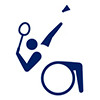 a Summer Games Paralympic Sport
a Summer Games Paralympic SportGoverning Bodies
International Governing Bodies

Badminton World Federation (BWF)
National Governing Bodies
United States

USA Badminton
Introduction:
Para-badminton is a variant of badminton for athletes with a range of physical disabilities. Badminton World Federation (BWF) is the main governing body for para-badminton starting from June 2011. The sport was governed by Para Badminton World Federation (PBWF) until a unanimous decision to join BWF during a meeting in Dortmund in June 2011.
History of the Sport:
Para badminton has been played internationally since the 1990s, but the sport really came to prominence in 2014. Following a bid by the Badminton World Federation (BWF) to include Para badminton as a Paralympic sport, the International Paralympic Committee (IPC) selected the sport for Tokyo 2020. Since then, it has continued to grow in popularity, moving from 230 athletes from 35 countries at 2015’s World Championships to more than 300 athletes from almost 50 countries competing at last year’s Worlds in Basel, Switzerland.
Rules – How to Play the Sport:
All matches are played best-of-three games. A game consists of 21 points and is won following the standard Badminton World Federation (BWF) scoring rules, laws and regulations except for the following modifications:
- Wheelchair Badminton – Is played on half court for Singles and full court for Doubles. The main difference is that in all levels of the game the front service line to the net is always ‘out’.
- Standing– Depending on the disability this category will play either on a half or full court in singles but always on a full court doubles.
- Short Stature/Dwarfs – Players in the Short Stature/Dwarf category will play on the standard full court for all events.
-
Wheelchair 1 WH 1 – Players in this class requires a wheelchair to play badminton. Players in this Sport Class usually have impairment in both lower limbs and trunk function.
-
Wheelchair 2 WH 2 – A player in this class could have impairment in one or both lower limbs and minimal or no impairment of the trunk. Players are required to play on a wheelchair in this class.
-
Standing Lower SL 3 – In this class a player must play standing. The player could have impairment in one or both lower limbs and poor walking/running balance.
-
Standing Lower SL 4 – A second standing class where the player has a lesser impairment compared to Sport Class SL 3. The player could have impairment in one or both lower limbs and minimal impairment in walking/running balance.
-
Standing Upper SU 5 – The players in this class has impairment of the upper limbs.The impairment could be on the playing or non playing hand.
-
Short Stature SH 6 – These are players who have a short stature due to a genetic condition often referred to as “dwarfism”.
Standard Equipment Modifications
- Wheelchair
- A player’s body may be fixed to the wheelchair with a strap either around the waist or across the thighs, or both.
- A player’s feet must be fixed to the footrest of the wheelchair.
- When a player strikes the shuttle, a part of the trunk and the legs shall be in contact with the seat of the wheelchair.
- The seat of the wheelchair, including any padding can be horizontal or angled backwards. It cannot be angled forward.
- A wheelchair may be equipped with a rear supporting wheel, which may extend beyond the main wheels.
- The wheelchair must not have any electric or other devices to assist movement or steering of the chair.
- Standing – Crutch
- An upper or lower leg amputee may use a crutch.
- The crutch must not exceed the players’ natural measurement from the armpit to the ground.
- Prosthetic Limbs
- An amputee player may use a prosthetic limb in categories SL3, SL4 and WH.
- The use of prosthetic limbs is not allowed in category SU5
- Any prosthetic limb shall have the same length as the players existing limb and be in proportion with the players other limbs.


